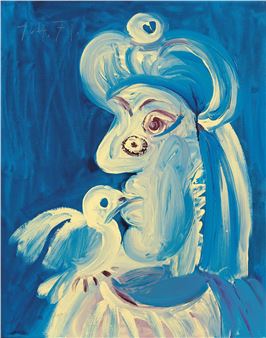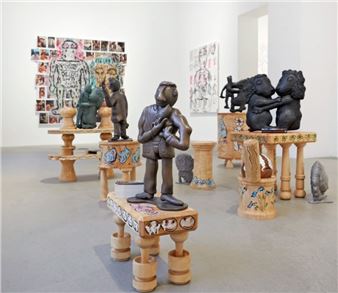When We See Us
The exhibition features over 148 works from institutional and private lenders located across 16 countries, bringing together artworks from the past 100 years, created by Black artists worldwide. The exhibition places these works in dialogue with Black thinkers, writers, and poets active today.
When We See Us, originally conceived and organized by Zeitz Museum of Contemporary Art Africa (Zeitz MOCAA), has been internationally acclaimed as one of the most significant exhibitions in the world focusing on Black representation and identity. Zeitz MOCAA is a groundbreaking institution in Cape Town, South Africa, dedicated to promoting and preserving contemporary art from Africa and its diaspora. With a primary focus on painting, the exhibition celebrates how artists from Africa and its diaspora have envisioned, positioned, memorialized and asserted experiences from Africa and of African descent. The exhibition is curated by Koyo Kouoh, who was recently appointed curator of the 2026 Venice Biennale, and co-curated by Tandazani Dhlakama, former Zeitz MOCAA Curator who recently joined Royal Ontario Museum (ROM) as Curator of Global Africa.
“When We See Us has resonated deeply with audiences in Cape Town, Basel, and now Brussels, where it continues to draw extraordinary engagement. This exhibition is a profound celebration of Black joy and liberation, grounded in a curatorial premise that boldly shifts away from centering violence. By embracing figuration as a canon—a form that is both deeply relatable and reflective—this show allows people to see themselves and their stories. It is my hope and belief that Stockholm will welcome this narrative with the same warmth and enthusiasm, further affirming the universal power of this work,” says Koyo Kouoh, curator of When We See Us and Zeitz MOCAA Executive Director and Chief Curator.
The exhibition is organized around six themes: The Everyday, Joy and Revelry, Repose, Sensuality, Spirituality, and Triumph and Emancipation. Figurative painting by Black artists has gained a new prominence over the past decade, and this exhibition connects these practices while uncovering deeper historical contexts and networks within a complex and underrepresented genealogy rooted in African and Black modernities.
“When We See Us presents an alternative modernity, highlighting artistic practices that have been historically excluded in Western Art History . The exhibition offers visitors a unique opportunity to experience art that has never been shown in Sweden,” says Joanna Sandell Wright, collaborating curator of the exhibition, director and artistic leader of Liljevalchs.
The title of the exhibition is inspired by Ava DuVernay’s 2019 miniseries When They See Us. By replacing “they” with “we,” a conceptual shift occurs, placing the conversation in a different perspective, with a focus on self-writing as theorized by Cameroonian political scientist and professor Achille Mbembe. When We See Us highlights the relationships between artists and artworks across geographical, generational, and conceptual boundaries, showcasing what Koyo Kouoh describes as a “parallel aesthetic.”
A hardcover poetic catalog, published in conjunction with the exhibition by Thames & Hudson in collaboration with Zeitz MOCAA and edited by Koyo Kouoh, will be available for sale in Liljevalch’s shop.The catalog is comprehensive and richly illustrated with all the works selected for the exhibition and includes a contextual essay by the exhibition’s co-curator Tandazani Dhlakama as well as four specially commissioned texts by acclaimed women writers: Ken Bugul (Senegal), Maaza Mengiste (Ethiopia), Robin Coste Lewis (USA) and Bill Kouelany (Congo-Brazzaville).

Recommended for you
The exhibition features over 148 works from institutional and private lenders located across 16 countries, bringing together artworks from the past 100 years, created by Black artists worldwide. The exhibition places these works in dialogue with Black thinkers, writers, and poets active today.
When We See Us, originally conceived and organized by Zeitz Museum of Contemporary Art Africa (Zeitz MOCAA), has been internationally acclaimed as one of the most significant exhibitions in the world focusing on Black representation and identity. Zeitz MOCAA is a groundbreaking institution in Cape Town, South Africa, dedicated to promoting and preserving contemporary art from Africa and its diaspora. With a primary focus on painting, the exhibition celebrates how artists from Africa and its diaspora have envisioned, positioned, memorialized and asserted experiences from Africa and of African descent. The exhibition is curated by Koyo Kouoh, who was recently appointed curator of the 2026 Venice Biennale, and co-curated by Tandazani Dhlakama, former Zeitz MOCAA Curator who recently joined Royal Ontario Museum (ROM) as Curator of Global Africa.
“When We See Us has resonated deeply with audiences in Cape Town, Basel, and now Brussels, where it continues to draw extraordinary engagement. This exhibition is a profound celebration of Black joy and liberation, grounded in a curatorial premise that boldly shifts away from centering violence. By embracing figuration as a canon—a form that is both deeply relatable and reflective—this show allows people to see themselves and their stories. It is my hope and belief that Stockholm will welcome this narrative with the same warmth and enthusiasm, further affirming the universal power of this work,” says Koyo Kouoh, curator of When We See Us and Zeitz MOCAA Executive Director and Chief Curator.
The exhibition is organized around six themes: The Everyday, Joy and Revelry, Repose, Sensuality, Spirituality, and Triumph and Emancipation. Figurative painting by Black artists has gained a new prominence over the past decade, and this exhibition connects these practices while uncovering deeper historical contexts and networks within a complex and underrepresented genealogy rooted in African and Black modernities.
“When We See Us presents an alternative modernity, highlighting artistic practices that have been historically excluded in Western Art History . The exhibition offers visitors a unique opportunity to experience art that has never been shown in Sweden,” says Joanna Sandell Wright, collaborating curator of the exhibition, director and artistic leader of Liljevalchs.
The title of the exhibition is inspired by Ava DuVernay’s 2019 miniseries When They See Us. By replacing “they” with “we,” a conceptual shift occurs, placing the conversation in a different perspective, with a focus on self-writing as theorized by Cameroonian political scientist and professor Achille Mbembe. When We See Us highlights the relationships between artists and artworks across geographical, generational, and conceptual boundaries, showcasing what Koyo Kouoh describes as a “parallel aesthetic.”
A hardcover poetic catalog, published in conjunction with the exhibition by Thames & Hudson in collaboration with Zeitz MOCAA and edited by Koyo Kouoh, will be available for sale in Liljevalch’s shop.The catalog is comprehensive and richly illustrated with all the works selected for the exhibition and includes a contextual essay by the exhibition’s co-curator Tandazani Dhlakama as well as four specially commissioned texts by acclaimed women writers: Ken Bugul (Senegal), Maaza Mengiste (Ethiopia), Robin Coste Lewis (USA) and Bill Kouelany (Congo-Brazzaville).

 ARTISTS
ARTISTS















